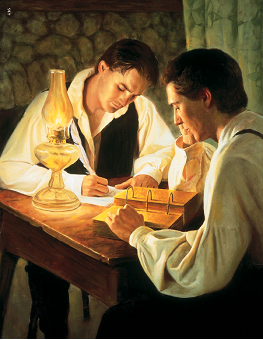FAIR Answers—back to home page
Question: What message does the Book of Mormon translation painting convey?
The translation was carried out openly—Joseph had no opportunity to hide notes or books
What religious message(s) does the Del Parson translation picture convey?

Artist's rendition of Joseph and Oliver translating the Book of Mormon.
- The translation was carried out openly—Joseph had no opportunity to hide notes or books. This was confirmed by Elizabeth Ann Cowdery and Emma Smith.[1]
- The plates had a physical reality, and Oliver Cowdery was convinced of this reality. Unlike some of the other Three Witnesses, who spoke only of seeing the angel and the plates, Oliver Cowdery insisted that "I beheld with my eyes and handled with my hands the gold plates from which it was translated. I also beheld the Interpreters. That book is true…I wrote it myself as it fell from the lips of the Prophet."[2] Oliver is also quoted in one account as describing Joseph "as sitting at a table with the plates before him, translating them by means of the Urim and Thummim, while he (Oliver) sat beside him writing every word as Joseph spoke them to him. This was done by holding the "translators" over the hieroglyphics..."[3] This alternative technique was confirmed by John Whitmer, who said of Oliver that "[w]hen the work of translation was going on he sat at one table with his writing material and Joseph at another with the breast-plate and Urim and Thummim. The later were attached to the breast-plate and were two crystals or glasses, into which he looked and saw the words of the book."[4]
- The translation was not a weird, esoteric exercise.
The hat detail causes problems for the critical theory that Joseph cheated with notes while dictating. With a curtain in place, it is much easier to postulate that Joseph used notes or a Bible in the translation process. With the stone and the hat, however, witnesses were able to view the entire process, thus highlighting the total lack of notes or Bible in the translation process. Note also that in Parson's painting, with it's open setting, the cheat-notes theory can't get any traction.
One needs to consider the impressive witness testimonies of the plates' reality, and the fact that the use of a seer stone in a hat is not intrinsically less plausible than the use of two seer stones mounted in a set of "spectacles" attached to a breastplate. In fact, there are even accounts which effectively mix the two methods, with Joseph purportedly removing one of the stones from the "spectacles" and placing it in a hat.
Efforts to diminish the miracle of the translation effort by emphasizing the substitution of one seer stone for another seems to convey something to a modern audience that it never portrayed to the participants—that the Book of Mormon was uninspired and uninspiring.
Notes
- ↑ Cowdery: “Joseph never had a curtain drawn between him and his scribe” [John W. Welch and Tim Rathbone, “The Translation of the Book of Mormon: Basic Historical Information,” F.A.R.M.S. report WRR–86, 25.] Emma: Joseph translated "hour after hour with nothing between us." [Joseph Smith III, “Last Testimony of Sister Emma,” Saints’ Advocate 2 (October 1879).]
- ↑ Reuben Miller Journal (21 Oct. 1848), LDS Church Historian's Office; Richard L. Anderson, "Reuben Miller, Recorder of Oliver Cowdery’s Reaffirmations," Brigham Young University Studies 8 no. 3 (Spring 1968), 278.
- ↑ Oliver Cowdery; as cited by Personal statement of Samuel W. Richards, 25 May 1907, in Harold B. Lee Library, BYU, Special Collections, cited in Anderson, "By the Gift and Power of God," 85.
- ↑ John Whitmer, in S. Walker, "Synopsis of a Discourse Delivered at Lamoni, Iowa," 26 Saints' Herald 370 (15 December 1879).

